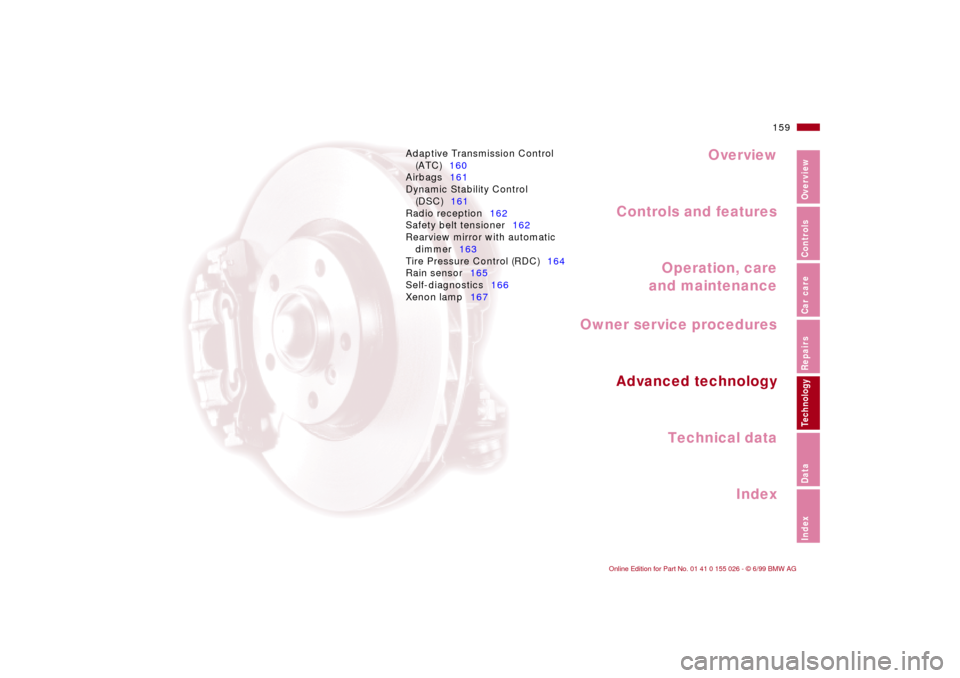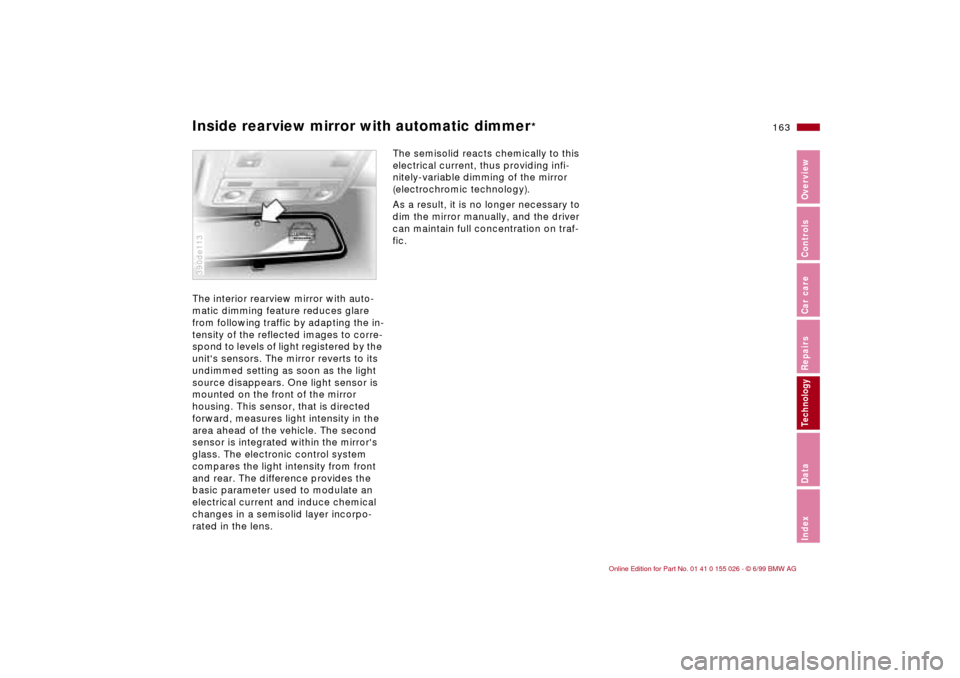sensor BMW 323Ci COUPE 2000 E46 User Guide
[x] Cancel search | Manufacturer: BMW, Model Year: 2000, Model line: 323Ci COUPE, Model: BMW 323Ci COUPE 2000 E46Pages: 189, PDF Size: 1.68 MB
Page 91 of 189

89n
RepairsIndexOverview Controls Car care Technology Data
Automatic climate control1 Air on the windshield and on the
side windows
2 Air flow toward upper body
The side rotary dials provide infi-
nitely-variable regulation of the air
supply, while the levers change the
air-flow direction. The center rotary
dial adjusts the temperature of the
air as it flows out, see page 92
3 Front footwell ventilation
There are corresponding air vents
in the rear footwell as well
4 Recirculated air mode/Automatic
recirculated-air control (AUC)
*
91, 92
5 Air supply91
6 Temperature90
7 Automatic air distribution90
8 Individual air distribution90
9 Air grill for interior temperature
sensor – please keep clear and
unobstructed
10 Display for temperature and air
supply90
11 Defrost the windows and remove
condensation91
12 Air conditioner91
13 Rear window defroster71, 92
Page 107 of 189

105n
RepairsIndexOverview Controls Car care Technology Data
Clothes hooks:
When suspending clothing from the
hooks, ensure that they will not obstruct
the driver's vision. In order to avoid per-
sonal injuries during braking maneu-
vers, do not hang heavy objects on the
hooks.
use with unleaded fuel only.
Even minute quantities of lead would be
enough to permanently damage both
the catalytic converter and the system
oxygen sensor.
To ensure efficient, trouble-free engine
operation and avoid potential damage:
>Be sure to comply with the scheduled
maintenance requirements
>Do not drive until the fuel tank is
empty
>Tow-start only when the engine is
cold, otherwise unburned, residual
fuel in the catalytic converter could
ignite and cause damage. It is better
to start the vehicle with an outside
starting aid
>Avoid other situations in which the
fuel is not burned, or burns incom-
pletely, such as engaging the starter
frequently or for extended periods, or
repeated start attempts in which the
engine does not start (stopping and
restarting an engine that is running
properly does not present a problem).
Never let the engine run with any of
the spark plug cables disconnected.Be sure to comply with the in-
structions above to prevent un-
burned fuel from reaching the catalytic
converter. Otherwise, the catalytic con-
verter could respond by overheating,
leading to serious damage.
Extreme temperatures occur at the cat-
alytic converter. Heat shields are in-
stalled adjacent to some sections of the
exhaust system. Never remove these
shields; do not apply undercoating to
their surfaces. When driving, standing
at idle, and parking the vehicle, take
care to avoid contact between the ex-
haust system and flammable materials
(grass, hay, leaves, etc.). Such contact
could lead to a fire, resulting in serious
injury and property damage.
Page 132 of 189

130n
Washing your car Right from the start, you can wash your
new BMW in an automatic car wash.
Car wash systems that do not employ
brushes are preferable.
Wipe away tough dirt and loosen and
remove dead insects before washing
the car.
To prevent spots, avoid washing when
the hood is still warm, or immediately
after and during exposure to strong
sunlight.
When using an automatic car wash, be
sure that:
>The car wash system is suited for the
dimensions of your vehicle
>No damage will occur on vehicles
with attached body accessories (such
as spoilers or antennas). Consult the
car wash operator if necessary
>The wheels and tires of your vehicle
cannot be damaged by the convey-
ance devices of the car wash system
>The vehicle is cleaned with minimum
brush pressure, and that ample water
is available for washing and rinsing.Vehicles with rain sensor:
Clean the windshield regularly. Wax
from car washes or the presence of
dead insects can cause rain sensor
malfunctions.
Switch the rain sensor off when
the vehicle passes through the car
wash (refer to page 70). Damage could
occur by an undesired actuation of the
wipers if the system is not deacti-
vated.<
Parts of the car that are inaccessible
to the automatic washer – such as door
sills, door and hood edges, etc. –
should be cleaned by hand.
In the winter months, it is especially im-
portant to ensure that the car is washed
on a regular basis. Large quantities of
dirt and road salt are difficult to remove,
and they also cause damage to the ve-
hicle.
If spray wands or high-pressure
washers are used, be sure to
maintain an adequate distance between
the spray source and the vehicle's sur-
face. Inadequate distance and exces-
sive pressure can damage or weaken
the finish, making it more susceptible to
subsequent attack. In addition, mois-
ture could penetrate to vehicle compo-
nents, leading to long-term damage.<
When cleaning the headlamps,
please observe the following:
>Do not rub dry. Never use abrasives
or strong cleaning agents to clean the
covers
>Remove dirt and contamination
(such as insects) by soaking with
BMW Car Shampoo and then rinsing
with plenty of water
>Always use a deicer spray to remove
accumulated ice and snow – never
use a scraper.<
After washing the car, apply the
brakes briefly to dry them. Braking
efficiency might otherwise be reduced
by the moisture and the brake rotors
could also be corroded.<
Caring for your car
Page 135 of 189

133n
RepairsIndexOverview Controls Car care Technology Data
Caring for your carPlastic components, vinyl upholstery,
headliners, lamp lenses, the clear cover
of the instrument panel and compo-
nents with a sprayed dull black surface
can be cleaned with water (add plastic
shampoo as required). Do not allow
moisture to soak through the seats or
headliner. Never use solvents such as
lacquer thinner, heavy-duty grease re-
mover, fuels, etc.
Rubber components should be cleaned
with water only; a rubber treatment or
silicone spray may also be applied.
Clean the wiper blades with soapy wa-
ter. The wiper blades should be re-
placed twice a year, before and after
the cold season. This especially impor-
tant for vehicles with a rain sensor.
Use only wiper blades approved
by BMW.<
The safety belts should be cleaned with
a mild soap and water solution without
removing them from the car. Never at-
tempt chemical or dry cleaning, as
damage to the belt fabric could result.
After cleaning, never allow the inertia
reel to retract the belts until they are
completely dry. Dirty safety belts pre-
vent the inertia reel mechanism from
retracting the strap properly, and thus
constitute a safety hazard.
Heavily soiled floor carpets and mats
*
can be cleaned with an interior cleaner.
The floor mats can be removed from the
vehicle for cleaning.
Please use only a damp cloth to clean
wooden fascia panels and components.
Follow up by drying with a soft cloth.
A full range of car-care products is
available from your BMW center.<
Care of upholstery materials Depressions in the upholstered materi-
als resulting from everyday use can be
brushed up by brushing "against the
nap" with a lightly dampened brush.
The tendency of the pile to lie in a par-
ticular direction on velour upholstery is
not a quality defect, and, just as on
home textiles or clothing, cannot be
avoided.
Lint on upholstery materials, textile or
leather remnants that have been worn
into the upholstery may be removed
with a lint brush or a Velcro
â brush. A
cleaning glove is available for particu-
larly "stubborn" lint. Stains and fairly
large areas of dirt should be cleaned off
without delay, using lukewarm water
and an interior cleaner, stain remover or
cleaning-grade benzene. Brush the fab-
ric afterwards to restore its appearance.
If the vehicle will be stored for an ex-
tended period, or if it is exposed to in-
tense sunlight, cover all seats or the
windows to prevent fading.
A full range of car-care products is
available from your BMW center.<
Page 161 of 189

Overview
Controls and features
Operation, care
and maintenance
Owner service procedures
Technical data
Index Advanced technology
159n
RepairsIndexOverview Controls Car care Technology Data
Adaptive Transmission Control
(ATC)160
Airbags161
Dynamic Stability Control
(DSC)161
Radio reception162
Safety belt tensioner162
Rearview mirror with automatic
dimmer163
Tire Pressure Control (RDC)164
Rain sensor165
Self-diagnostics166
Xenon lamp167
Page 163 of 189

161n
RepairsIndexOverview Controls Car care Technology Data
Deceleration sensors continuously
monitor the physical forces acting upon
the vehicle. If, as the result of a frontal
collision, a deceleration is reached at
which the protection of the safety belts
alone is no longer adequate, the gas
generators of the driver and passenger-
front airbags are ignited. However, the
passenger-side airbag is only triggered
if an additional sensor has recognized
that the passenger seat is occupied.
In the event of a side collision, the Head
Protection and side airbags in the front
or rear
* are triggered if necessary.
390de319
The airbags located under the marked
covers inflate and unfold in a matter of a
few milliseconds. In this process they
tear through the rated breaking points
of the upholstered covers or press them
out.
Because the inflation process must be
virtually instantaneous, it is necessarily
accompanied by a certain amount of
ignition and inflation noise. The gas
required to inflate the airbags is not
dangerous, and the associated smoke
then dissipates.
The entire process is completed within
fractions of a second.Highly sensitive sensors monitor the
number of revolutions of the wheels,
steering angle, lateral acceleration,
brake pressure and the movement of
the vehicle around its vertical axis.
If differences in the wheel speeds oc-
cur, the system counteracts the danger
of wheelspin by reducing engine torque.
If necessary, the system also responds
with additional application of the brakes
at the rear wheels.
If the system detects an instability in the
vehicle's condition, the braking action
can also be directed to the front wheels
by the DSC in order to help stabilize the
vehicle.
You may need some time to become
accustomed to this system's interven-
tion. However, it provides optimum pro-
pulsive force and driving stability.
The braking intervention may be ac-
companied by a certain degree of
noise.
Airbags DSC
Page 165 of 189

163n
RepairsIndexOverview Controls Car care Technology Data
Inside rearview mirror with automatic dimmer
*
The interior rearview mirror with auto-
matic dimming feature reduces glare
from following traffic by adapting the in-
tensity of the reflected images to corre-
spond to levels of light registered by the
unit's sensors. The mirror reverts to its
undimmed setting as soon as the light
source disappears. One light sensor is
mounted on the front of the mirror
housing. This sensor, that is directed
forward, measures light intensity in the
area ahead of the vehicle. The second
sensor is integrated within the mirror's
glass. The electronic control system
compares the light intensity from front
and rear. The difference provides the
basic parameter used to modulate an
electrical current and induce chemical
changes in a semisolid layer incorpo-
rated in the lens.390de113
The semisolid reacts chemically to this
electrical current, thus providing infi-
nitely-variable dimming of the mirror
(electrochromic technology).
As a result, it is no longer necessary to
dim the mirror manually, and the driver
can maintain full concentration on traf-
fic.
Page 166 of 189

164n
Tire Pressure Control (RDC)
*
This system regularly checks tire pres-
sures and monitors all four tires even
while driving, so you don't have to.
Behind the valve stem in every wheel,
there is an extended-life electronic chip
that has a pressure sensor, a transmit-
ter and a battery. The pressure is mea-
sured in extremely short time intervals
and then transmitted by a radio signal.
If an irregularity is detected, the trans-
mission rate is increased. 462de257
Near every wheel there is an antenna in
the body that receives the signals from
all four wheels. A central electronics
system evaluates the quadruple signals
and forwards any changes. The RDC
plays an important part in driving safety.
Page 167 of 189

165n
RepairsIndexOverview Controls Car care Technology Data
Rain sensor
*
Depending on the degree of wetness
on the windshield, the rain sensor con-
trols the operation of the windshield
wipers.
Infrared light is carried along the sur-
face of the windshield in an optical con-
ductor in such a manner that it is
reflected completely when the wind-
shield is dry. The quantity of reflected
light is measured.
If there is moisture on the glass, the
amount of light reflected is reduced
since the infrared light at the surface of
the windshield can escape. The quan-
tity of reflected light is thus a means of
gauging the degree wetness on the
windshield.390de133
When the "Intermittent" wiper speed
position is selected, the wiper reacts
immediately if water is splashed onto
the windshield from vehicles traveling
ahead, for example. As a result, the rain
sensor provides a contribution to driv-
ing safety and comfort.
Page 182 of 189

Everything from A to ZGGasoline 26
Gasoline gauge 75
Glove compartment 94
Glove compartment lamp
bulb replacement 146
Grills 88
Gross weight 172HHandbrake 64
Hands-free system 95
Hazard warning system 25
Hazard warning triangle 25
Head restraint 48
Headlamp covers,
care 130, 141
Headlamp flasher 85
Headlamp washer
system 122, 173
Headlamp washers 71
Heated mirrors 52
Heated seats 93
Heater and ventilation 88
Heavy loads 100
Height 171
HiFi System – harman
kardon 94
High beams 23, 69, 85
bulb replacement 141
Hood release 119
Horn 17
Hubcap 149
IIce warning 78
Icy roads 78
Identification, tires 115
Ignition key 32
Ignition lock 62
Indicator lamps 20
Inflation pressure 27, 113
Inflation pressure
monitoring 82, 164
Inside rearview mirror,
automatically set for low-
beam lights 53
INSPECTION 76
Installing child restraint
system 61
Instrument cluster 18
Instrument lighting 84
Instrument panel lighting 84
Interaxle tire rotation 114
Interface socket 96
Interface socket for On-
Board-Diagnostics 137
Interference
cellular phones 112
Interior lamp 36, 85
bulb replacement 145
remote control 36
Interior mirror 52
automatic dim 163
Interior motion sensor 42
Interlock 62
Intermittent wipe 69
JJack 148
Jump-starting 156KKey 32
Key Memory 54LLamp switch 84
Lamps on warning 84
Lashing eyes 100
Leather care 134
Length 171
License plate lamp
bulb replacement 145
Light-alloy wheels 117
Lighter 96
Load-securing devices 100
Low beam headlamps 84
Low beams
bulb replacement 141
Low-beam light inside
rearview mirror 53
Lug bolts 149
Luggage compartment 39
capacity 172
emergency release 39
floor mat 41
floor panel 41
remote control 37Luggage compartment
lamps
bulb replacement 146
Luggage compartment
lid 39
emergency release 39
Luggage compartment
lighting 39
Luggage rack 101
Lumbar support 49
MM+S tires 116
Maintenance 76, 129
Malfunction displays 77
Manual transmission 65
Manually controlled
recirculated-air 91
Memory 51
MFL (Multi-function steering
wheel) 24
Microfilter 93, 154
Microphone 95
Mirror memory 51
Mirrors 52
Mobile phones 112
Modifications,
technical 6, 136
Multi-function steering wheel
(MFL) 24